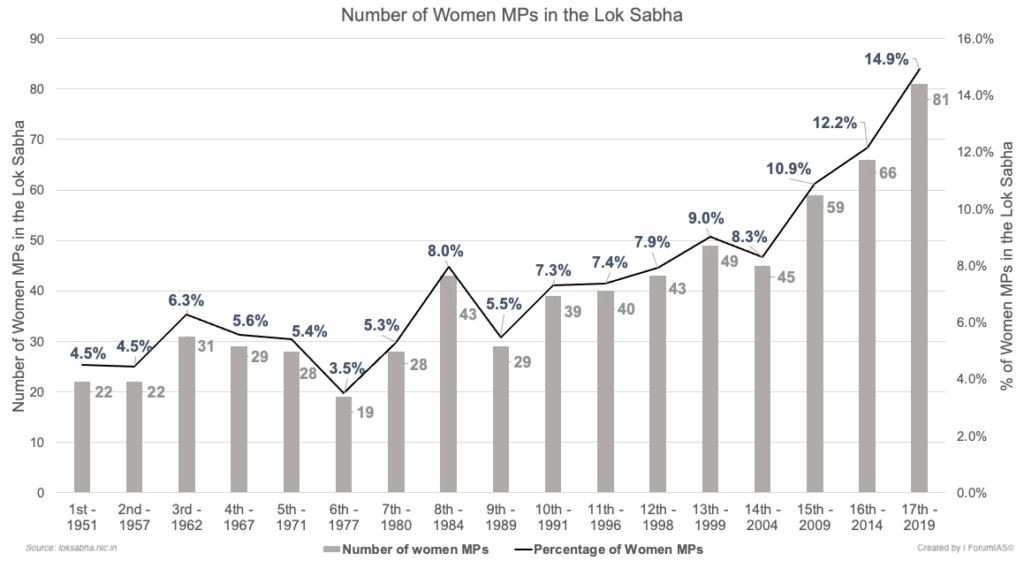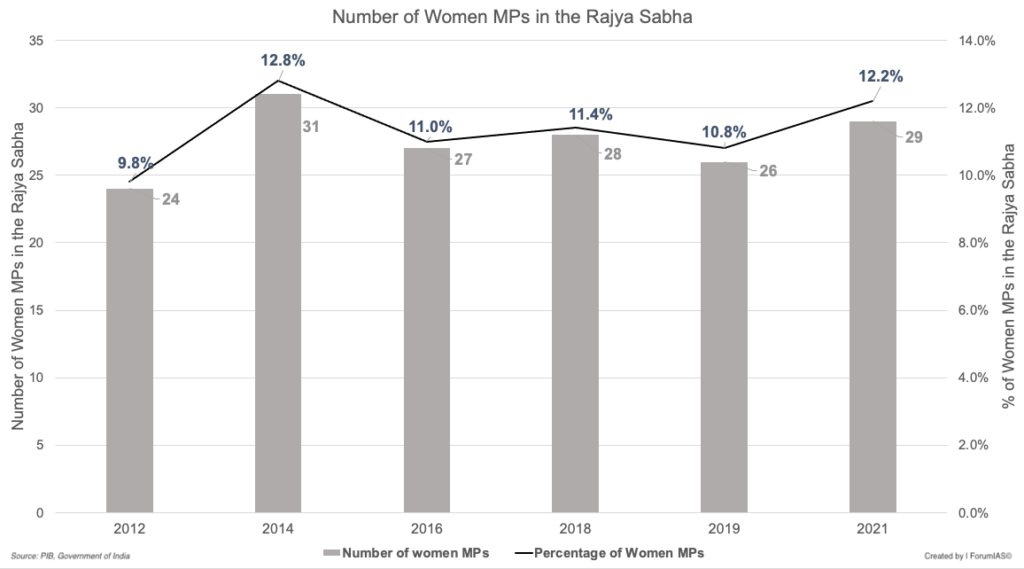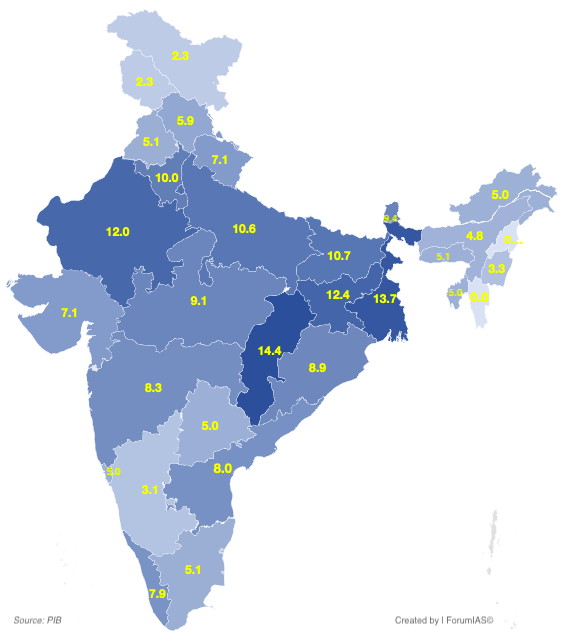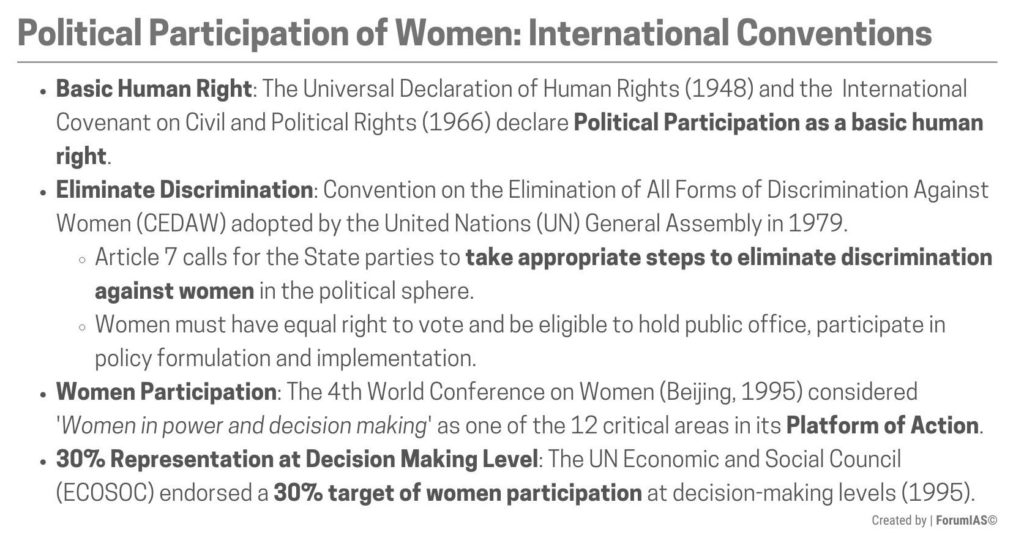ForumIAS announcing GS Foundation Program for UPSC CSE 2025-26 from 19 April. Click Here for more information.
Contents
- 1 Introduction
- 2 What is the current status of Women’s Representation in Legislature?
- 3 What are the reasons for low Representation of Women in Legislature?
- 4 What are the benefits of high Representation of Women in Legislature?
- 5 What steps have been taken to improve Women’s Representation in Legislature?
- 6 What should be done going ahead?
- 7 Conclusion
| For 7PM Editorial Archives click HERE → |
Introduction
A PIL has been filed in the Supreme Court seeking reintroduction of the lapsed Women’s Reservation Bill for 33% quota in the Lok Sabha and the State Legislative Assemblies. The Supreme Court has sought the response of the Union Government to the PIL in 6 weeks. Enhancing women’s representation in the Legislature through reservation has been a debatable and contentious issue. Despite persistent efforts for long, there has been lack of consensus on the issue. There has been an upward trend in women’s representation in Legislature in India in recent times, yet it is much below the desired levels. In fact, many African countries fare better than India. There is a need for renewed push towards efforts in this regard as studies have shown that women’s representation has a major impact on inclusive and gender development issues.
What is the current status of Women’s Representation in Legislature?
The number of women members in the Lok Sabha has shown a regular increasing trend in the recent times. The number of Women MP’s in Lok Sabha has increased from 45 (8.3%) in 2004 (14th Lok Sabha) to 81 (14.9%) in 2019 (17th Lok Sabha).
The women membership in the Rajya Sabha hasn’t shown the similar rising trend.
The representation of women in State Legislative Assemblies has been low. The highest is in Chhattisgarh (14.4%) followed by West Bengal (13.7%) and Jharkhand (12.4%).
Source: PIB. Percentage of Women Representatives in State Legislative Assemblies as on December 31, 2021. The proportion for Jammu and Kashmir/Ladakh is based on last elections held in 2014.
Even though the percentage of female lawmakers in the Lok Sabha reached a record high of ~15% in the 17th Lok Sabha, India ranks lower than 140 other nations in terms of the number of women serving in their national legislatures. According to the Inter-Parliamentary Union (IPU) ‘Women in Parliament’ Report (2021), the global percentage of women in parliament was 26.1%.
According to the IPU’s latest status report (as of October 2022), Rwanda (61.3%), Cuba (53.4%), Nicaragua (51.7%), Mexico (50%), UAE (50%) are the top performers in terms of women’s representation in legislatures. In India’s neighbourhood, Nepal (33.6%), Bangladesh (20.9%), Pakistan (20.5%), Bhutan (17.4%) perform better than India.
What are the reasons for low Representation of Women in Legislature?
Gender Gaps in Political Ambition: Several factors associated with gender conditioning may lead to lack of political ambition in women: (a) Women are less encouraged to run for office/election than men; (b) Women are less likely to believe that they are more qualified for office than men; (c) Women’s tendency to shy away from competition may also play a role since the political selection process is likely perceived as highly competitive; (d) The fear of ‘big politics’ and factors such as self-doubt, stereotypes and personal reservations often prevent even the most politically gifted women from entering government; (e) Women’s willingness to advance in their political careers can also be influenced by family and relational considerations. In Sweden female politicians who are promoted to mayor (i.e. the highest office in municipal politics) experience a significant increase in the likelihood of divorcing their partner, whereas this is not the case for men.
Patriarchal Society: (a) Gender Disparities: There are still many obstacles in the way of women in positions of leadership due to gender inequality in areas like as education, access to resources, and the persistence of biased views; (b) Sexual division of labour: Women are responsible for the majority of housework and child care; (c) Cultural and Social Expectations: Cultural and Social Expectations are forced upon women which prevent women from participating in politics; (d) Illiteracy: It’s a major barrier to women’s advancement in the political sphere. On average, female applicants had lower levels of education and work experience than their male counterparts.
Cost of Contesting Election: Cost of contesting elections is rising with times. Lack of access to resources and assets means that women are much less likely to be able to raise the funds for contesting elections than men.
Gate-keepers: Party leaders, who often are key players in the selection of candidates, may prefer to promote male rather than female candidates. There may be bias in the thinking regarding winnability of female candidates preventing them from selecting women leaders for election.
In addition to the aforementioned factors, the exodus of women from politics is also attributable to a lack of political education, a considerable growth in criminalization and corruption.
What are the benefits of high Representation of Women in Legislature?
Focus on Gender issues: According to UN Women, higher numbers of women in parliament generally contribute to stronger attention to women’s issues. This can ensure appropriate policy response to address gender issues and introduce women-sensitive measures.
Gender Equality: Women’s political participation is a fundamental prerequisite for gender equality and genuine democracy. It can help establish public enquiries on women’s issues and use findings to place issues on government agendas and within legislative programmes.
Accountability: It facilitates women’s direct engagement in public decision-making and is a means of ensuring better accountability to women.
Gender-sensitive Governance: It helps in undertaking reforms that can help make all elected officials more effective at promoting gender equality in public policy and ensuring their implementation.
Encourage Inclusive Initiatives: Improved Women’s representation in Legislature can encourage the provision of financial incentives to programmes/projects designed to facilitate women’s decision-making endeavours (e.g. for leadership-training schools, increasing government subsidies to political parties with more women in leadership positions/candidates; introducing a specific women’s budget earmarked for enhancing women’s decision making).
Change Stereotypes: Enhanced representation can help cooperate with the women’s movement and the media to change the stereotyped image of women as only ‘homemakers’, and to portray them as effective and efficient politicians and to normalise the image of a woman politician.
What steps have been taken to improve Women’s Representation in Legislature?
Constitutional: (a) Article 14 has established equality as a fundamental right. It inevitably necessitates equal opportunity, as stated in Article 15; (b) Article 46 puts on the state the responsibility to safeguard vulnerable groups against social injustice and all forms of exploitation; (c) Article 243D of the Constitution ensures participation of women in Panchayati Raj Institutions by mandating at least 33% reservation for women in total seats and the offices of chairpersons of Panchayats; (d) Article 326: Elections to the House of the People and to the Legislative Assemblies of States to be on the basis of adult suffrage.
Legislative: (a) Parliamentary Committee on Empowerment of Women: In 1997 (11th Lok Sabha), the Committee on Empowerment of Women was formed to advance the position of women; (b) Gender-Neutrality: Under the leadership of Meira Kumar, who was the Speaker of the Lok Sabha at the time, the rules of the Lok Sabha were made completely gender-neutral in 2014. Since then, every document has called the head of a Lok Sabha Committee the Chairperson; (c) The Women’s Reservation Bill (2008)(108th amendment) was tabled to reserve 33% of Lok Sabha seats for women. However, there has been lack of consensus among political parties regarding grant of reservation to women.
International Covenants: Globally, several international commitments have been made, for achieving gender equality and these have emphasized on enhancing women’s representation in political sphere. While the Convention on the Elimination of All Forms of Discrimination against Women (1979) upheld women’s right to participate in public life, the Beijing Platform for Action (1995) called for removing barriers to equal participation. The Millennium Development Goals (2000) and the Sustainable Development Goals (2015-2030) also took into account women’s representation in parliament to measure progress towards gender equality.
Article 25 of the International Covenant on Civil and Political Rights, (binding on signatory states including India), says that “Every citizen shall have the right and the opportunity, without unreasonable restrictions to vote and to be elected at genuine periodic elections”.
What should be done going ahead?
According to a study by the IPU, several corrective steps can be undertaken to enhance women’s representation in the Legislatures.
Setting Quotas for Female Representation: According to the IPU’s 2021 Women in Parliament report, among the 30 countries that had quotas in place for their single/lower house in 2021, 31.9% of MPs elected were women, compared to 19.5% in countries with no quotas. However, quotas alone may not increase women’s representation. Clear, well-structured and well-drafted regulations with effective enforcement mechanisms must be put in place.
Reservation of seats for women faces opposition as it restricts choice of voters. Therefore, some experts have suggested alternate methods such as allocating minimum 33% tickets to women candidates in election and dual member constituencies.
End Violence against Women in Politics: According to an IPU report (2016), nearly 82% of 55 women parliamentarians surveyed from 39 countries reported first-hand experience of psychological gender-based violence during their political careers, while 44% of the women surveyed stated that they had been physically threatened during their time in office. Online and offline hate speech, sexist comments, sexual harassment and physical assault are also widespread, and are regularly used as tactics to dominate and silence women in politics. These need to be tackled by establishing cross-party, mixed-gender working groups in parliaments across the globe to eliminate gender-based violence; develop standards and policies to combat sexism and harassment; and establish an independent, confidential and fair complaints system that those working in Legislatures can trust.
Mentoring: A 2021 UNDP study found that tutorship programmes, including those developed by political parties, help to connect women with more experienced female politicians and gain the necessary experience by learning from their insight. Newcomer Women parliamentarians can also benefit from mentorship, by helping them become leaders and progress in their careers.
Increase Women’s Participation in Media: A 2020 Journal of Communication study found that women are still stereotypically disassociated from public life and politics, . Media coverage tends to focus more on a woman parliamentarian’s personal background, clothing, marital status and children etc. Educating journalists, calling attention to bias and creating projects that monitor press treatment of women politicians, parliamentarians and presidential candidates – and document sexist coverage – are all effective ways to increase women’s representation in the media.
Expand participation through Women’s Caucuses: Women’s parliamentary caucuses allow Women Parliamentarians to work collaboratively across party lines to foster gender equality legislation and policy agendas. They can help amplify women’s voices and influence in parliament. It is imperative that additional efforts, organizational support and leadership are provided for caucuses to succeed.
Conclusion
Improving women’s representation in legislatures can have a large positive impact in ensuring gender inclusive development. It is time that political parties should overcome their differences and take initiatives to improve political participation of women. Some political parties have started fielding more women candidates. However, there is a need to institutionalize such mechanisms to make them more effective. This will ensure women empowerment in true sense.
Syllabus: GS I, Social Empowerment; GS II, Parliament and State Legislatures Functioning and Issues arising out of these; GS II, Government policies and interventions for development in various sectors and issues arising out of their design and implementation.
Source: The Times of India, The Times of India, PIB, IPU








